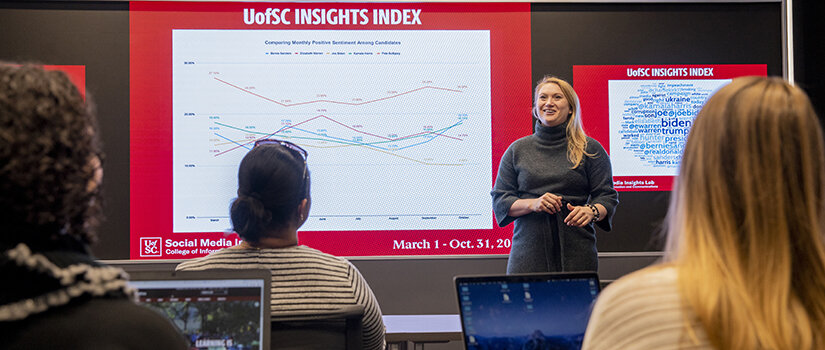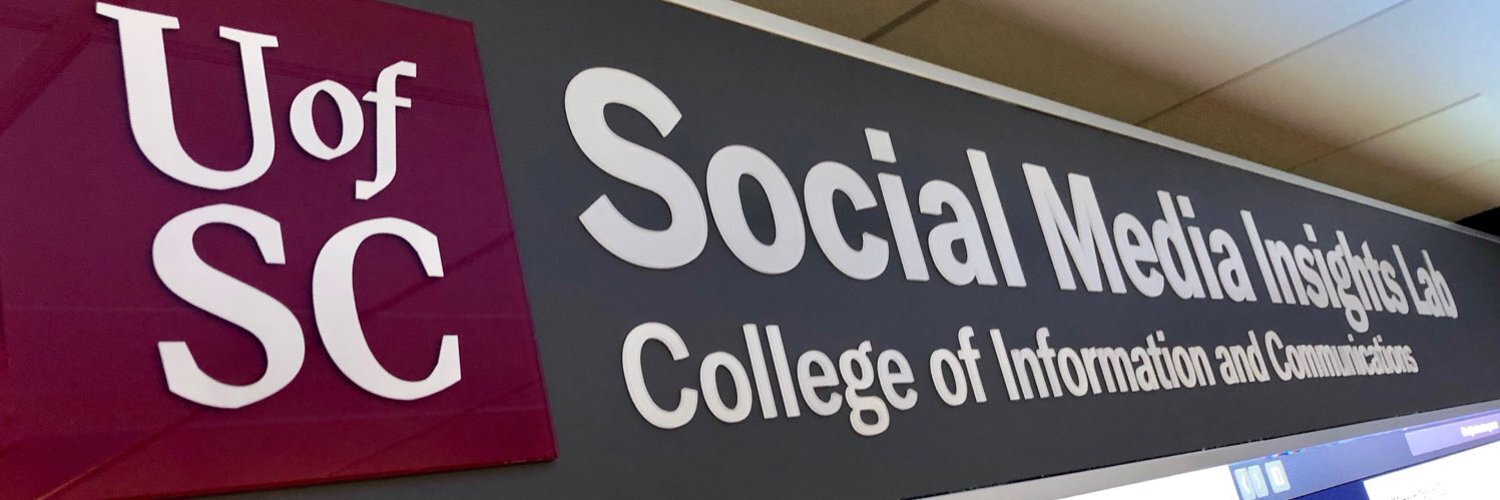
Powerful AI Technology Tracks South Carolina’s Social Media Response to COVID-19
Crimson Hexagon Delivers Critical Data Interpretation to CIC’s Social Media Insights Lab
By: Taylor Bohnke
COLUMBIA, SC. — April 17, 2020 — As of 2020, 79% of the population in the United States maintains an active social media profile.
The Social Media Insights Lab at the College of Information and Communications understands just how integrated social media conversations have become in our lives. Located on the first floor at the School of Journalism and Mass Communications, the Social Media Insights Lab monitor and analyze social media conversations to track sentiment and identify emerging trends to provide decision-makers the information they need to make strategic decisions.
Being fully operational for a year and a half now, the lab features Crimson Hexagon software powered by AI-technology to help generate, visualize and interpret data. The software searches social media conversations, blogs and websites — dating back to more than a decade.
Kait Park, lab manager and lead analyst at the Social Media Insights Lab, said, “It’s a very powerful social media listening tool. It allows us to look at social media across 24 languages across the entire globe. But also, what’s really special about Crimson Hexagon is that it uses artificial intelligence to tell us the percentage of positive versus negative sentiment that exist in a conversation.”
For clients of Crimson Hexagon, analyzing consumer sentiment is key to better understanding their audience and evaluate the effectiveness of public relations initiatives. Previously, the Social Media Insights Lab involved their time with predicting the outcome of the 2020 presidential election, but amidst the COVID-19 pandemic their focus has shifted to crisis response projects for the time being.
Learn about Crimson Hexagon.
“Were very focused on COVID-19 and the coronavirus pandemic. So, that’s really where that public-facing reporting has shifted to now. We’ve been releasing mini-reports on our Twitter and on our website about how South Carolinians are reacting and responding to how this changes from day to day. And then, what does the united states as a whole — what does the social media conversation around the pandemic look like? And then, trying to find, while still being sensitive to COVID-19, other things that are happening and how we can open up the conversation to what else everyone is talking about on social media,” Kait Park explained.
The lab has been analyzing the response to COVID-19 on social media since the beginning of March. Park explained that, in the beginning, South Carolina was not very engaged in the conversation around the virus, attacking the media with a lot of negative sentiment. Words like the term “hoax” were being used in conversation instead of “reaction” and such.
“People were saying, ‘This is an overreaction. This will go away. This is not going to affect us,” Park said , “and then, the next day is when the WHO declared this a pandemic…”
The number one word had become pandemic, and concerns began to rise around the subject of coronavirus testing. There was a significant shift from the mindset of ‘this is not going to affect us’ to ‘I’m very worried now’.
“What we're looking at more so than we ever did with our previous reports are the emotions that users express. Because understanding how we feel, mental wellness and mental health in a time where people feel this interruption or disruption in their daily lives. They’re feeling very isolated; So, we’ve been very careful to note trends related to emotion”, Park expanded on the labs focus during this crisis.
After about a week of concern and chaos, Park said that they began to see a lot of optimism coming from users. Seeing lots of trends about prayer and faith.
However, as things are continuously changing across social media, currently the predominate emotion has been sadness.
Park expressed, “Social media’s not going anywhere. But, the more that we can understand about it, the better we can be as communicators…Being able to interpret what matters the most, what people are talking about the most, and how does it make them feel, is just going to make us even better communicators. Analytics and listening takes the guess work out of communications. You know you don’t have to create a plan or strategy out of thin air.”
The Social Media Insights Lab has been an irreplaceable addition to the CIC. It positions the College as a thought-leader in social media analytics and enhances the university’s research efforts.
The lab has three main goals:
To introduce social media listening and how it can be applied in classrooms.
Working with faculty and students and real clients to help them reach their research goals.
To be an advocate for social media listening in journalism, finding valuable insights that are really newsworthy.

Kait Park, Lab Manager and Lead Analyst Presents Insights on the 2020 Presidential Campaign.
For the first time ever, the SJMC will be offering a social media analytics course taught by Dr. Anli Xaio, who has joined the SJMC as the assistant professor of public relations. Students will learn where to find data on social media, what kinds of questions to ask for clients, and then how to analyze and interpret their findings.
Xaio is excited to bring this class to life: “There is great potential in social media analytics, in terms of content strategizing, and learning where to communicate…I believe you have to learn how to communicate findings, and then make sure your findings can be transferable into actual insights.”
The course will be first available to CIC undergraduate students this summer 2020.
For now, the Social Media Insights Lab continues their research during the COIVD-19 pandemic in its evolving state.
Park surmised, “We are all shifting to a digital communications lifestyle in a time of self-isolation. So, it just shows how much value in an event like this, being able to understand what people are saying and how it makes them feel is going to be invaluable.”
About the CIC: Founded at USC in 1923, The School of Journalism and Mass Communications is one of the oldest communications schools in the country. The College of Information and Communications was created in 2002, allying the School of Journalism and Mass Communications and the School of Library and Information Science, in order to reflect the evolving information and communications landscape. The school teaches communication of all types — from time-tested techniques to the unbounded possibilities of digital media.
Contacts
Kaitlyn Park
Lab Manager and Lead Analyst
Email: parkkm@mailbox.sc.edu
Dr. Anli Xaio
Assistant Professor of Public Relations
Email: XIAO@mailbox.sc.edu





